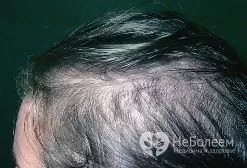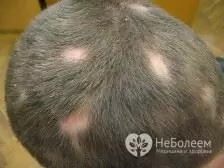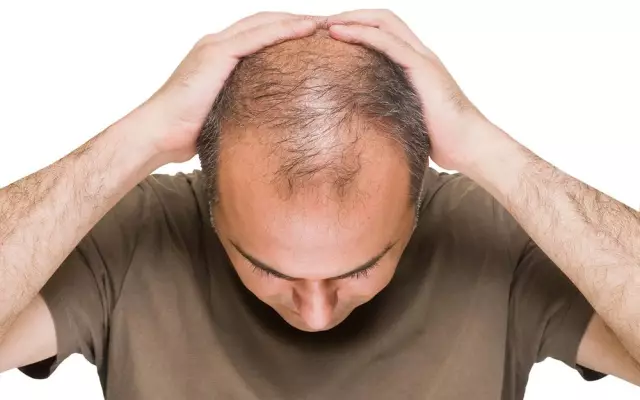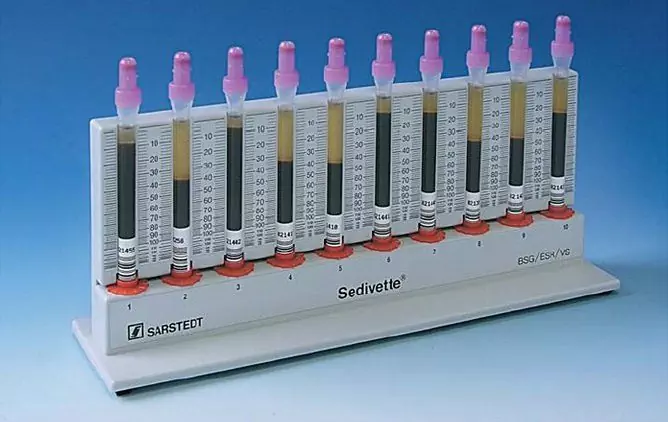- Author Rachel Wainwright [email protected].
- Public 2023-12-15 07:39.
- Last modified 2025-11-02 20:14.
Alopecia
Brief description of the disease
Alopecia is a Latin word that literally means baldness. This condition should not be confused with hair loss, which is part of natural hair renewal and occurs regularly in everyone. If you are diagnosed with alopecia, treatment is simply necessary, because in its absence, you can very quickly lose all hair.
Types of alopecia

Androgenic alopecia - appears due to an increased level of testosterone or due to an abnormally high sensitivity of the hair to the presence of this hormone. In the latter case, baldness can occur even with normal testosterone levels. Androgenic alopecia is most often observed in women, especially during pregnancy and lactation, as well as during menopause. In men, this type of disease is detected much less frequently and mainly affects the elderly.
Diffuse alopecia is a consequence of any serious disease or disturbances in the work of the main body systems. In addition, this form can be caused by stress, iron deficiency and poor diet. Diffuse alopecia is characterized by the fact that hair falls out profusely and evenly, which partly makes it difficult to make a correct diagnosis.
Alopecia areata (another name is alopecia areata) - equally often manifests itself in women and men at any age. A symptom of the disease is the appearance of several balding areas on the head or hair loss on other areas of the body, for example, on the beard and eyebrows. Over time, the bald spots can move or disappear altogether. The reason a person begins to develop alopecia areata is unclear. Researchers believe there is a malfunction in the body's immune system.
Once again I want to repeat that you should not confuse the cause with the effect. So, for example, very often the diagnosis of alopecia in women is not confirmed during the prescribed treatment, since hair loss is associated with seasonal factors or with pregnancy and childbirth. Temporary baldness is also observed in cancer patients after a course of chemotherapy. For this reason, androgenic alopecia and other forms of the disease are diagnosed only after a comprehensive examination and research of the necessary tests.
Alopecia - treatment of the disease

When diagnosed with alopecia areata, patients are prescribed immunocorrective therapy. As mentioned above, this form is considered an autoimmune disease, which is partly confirmed by the high efficacy of immunomodulators and non-specific immunotherapy agents taken by the patient.
If alopecia is associated with disorders of the nervous system, then it is necessary, first of all, to get rid of psycho-emotional experiences, the consequences of craniocerebral injuries, autonomic disorders. If necessary, the patient is prescribed tranquilizers, sedatives, vegetotropic drugs, 2% novocaine solution. Sometimes a course of hypnotherapy is given.
Diffuse alopecia, caused by malnutrition, anemia and hypovitaminosis, is treated with biogenic stimulants (phytin, aloe or placenta extract, aloe syrup with iron). Good results are shown by sodium arsenate, which is injected subcutaneously 2-3 times a day, and a solution of novocaine. Folk remedies are also very popular, in particular, tinctures of lemongrass, zamaniha and aralia.
Often human baldness is associated with seborrhea, erythroderma and other dermatoses. If they are caused by alopecia, the treatment consists in eliminating the cause, that is, directly dermatoses, after which the process of hair loss stops. Please also note that bald spots can be the result of taking certain medications (sex hormones, isoniazid, anorexics, anticoagulants), intoxication, exposure to X-rays and frequent perm. In children, physiological alopecia is most often manifested. It does not require any special treatment and goes away by itself after a certain period of time.
Severe forms of the disease, accompanied by the development of scars and atrophic changes in the skin, are practically not amenable to treatment, since negative processes affect the system of hair renewal, completely stop its normal functioning. There are exceptions, but they are quite rare and positive dynamics can be achieved only with prolonged, complex treatment in specialized clinics.
Since alopecia in women and men is often associated with poor nutrition, patients are prescribed a strict diet. They are limited to the amount of table salt in food, include in the standard diet a large amount of vegetables, fruits, liver, fish, milk, legumes, potatoes and cereals. One of the most effective ways to lose weight and cleanse the body of toxins is a cucumber diet. At the same time, local therapy is carried out, that is, all kinds of means and ointments are used, which are rubbed into the baldness focus.
YouTube video related to the article:
The information is generalized and provided for informational purposes only. At the first sign of illness, see your doctor. Self-medication is hazardous to health!






